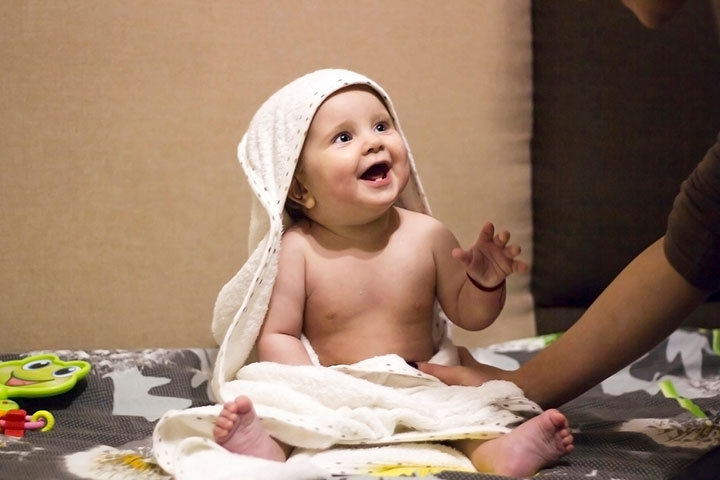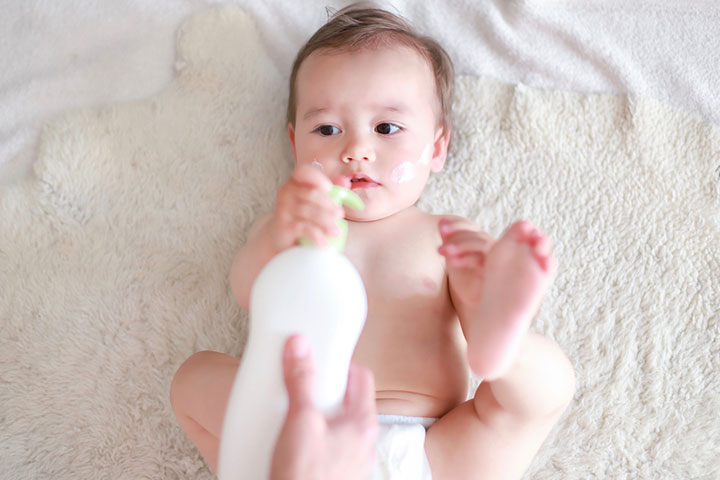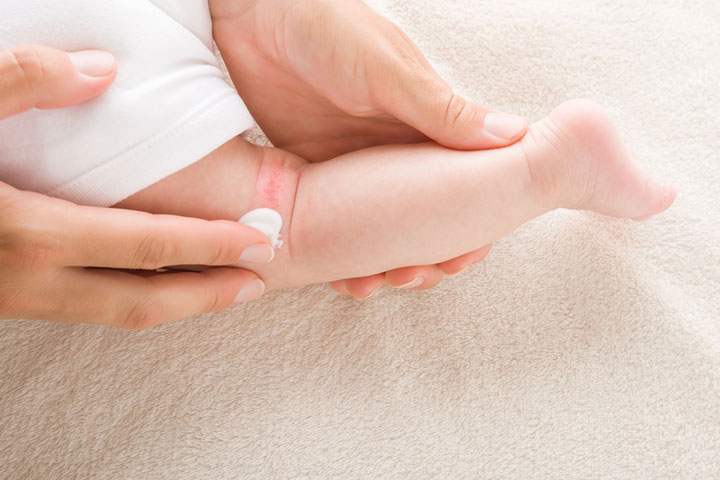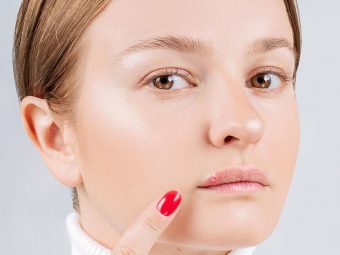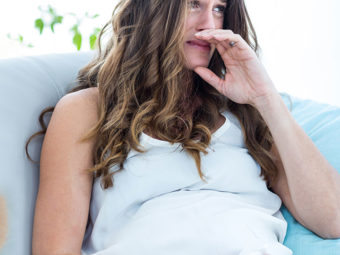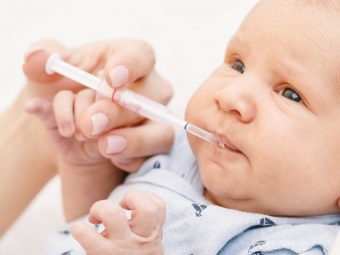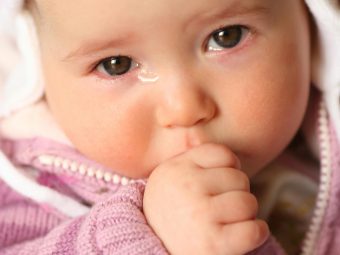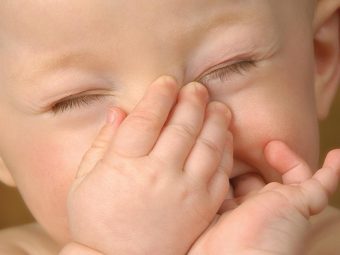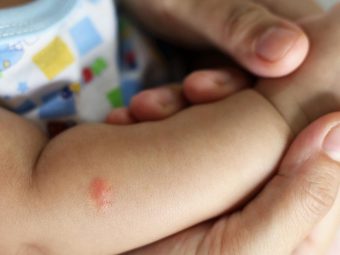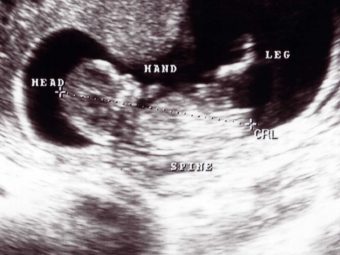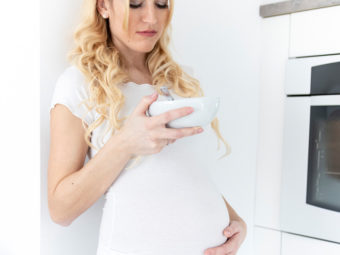
Image: iStock
A baby’s skin is different and way more delicate than that of an adult. This makes it more prone to getting affected by external agents that cause rashes, irritation, or dryness. Dry skin in babies usually does not require medications for treatment, as simple home remedies may be sufficient. Read on as we tell you details about dry skin conditions in babies, preventive measures, and ways to treat them.
Newborn Skin Peeling
Image: IStock
Peeling of the skin is completely normal in newborns and requires no treatment (1). At birth, a newborn’s skin is thinner, less hairy, and has fewer sweat glands (2), as it is covered with various fluids such as amniotic fluid and vernix (a cream-cheese-like substance that covers and protects newborn’s skin from right inside the womb) (3).
These fluids are wiped off after birth, exposing the baby’s skin to natural elements outside the uterus for the first time. This renders the baby’s skin susceptible to peeling in the initial weeks of birth.
The amount of peeling depends on whether the baby was premature, full-time, or overdue. Premature babies have more vernix, and thus the skin peeling for them is usually less when compared to over-due or full-term newborns (4).
Experts state that newborns do not need any additional moisturization or lotions in the first month of their life (5). Nevertheless, parents may apply lotion after consultation with a pediatrician.
Just as in newborns, skin dryness is common in babies too.
What Are The Symptoms Of Dry Skin In Babies?
Here is what you notice when a baby has dry skin (6):
- White scales that peel at the edges
- Roughness and scaly texture
- Flakiness when the skin is rubbed
- Dry red patches
- Fine to deep cracks on the skin, and deeper cracks may bleed occasionally
- Overall skin appears tight and overstretched
Symptoms of dry skin in babies can help in identifying the cause. However, the causes could be diverse and may range from day-to-day skincare issues to some medical conditions such as eczema.
What Causes Dry Skin In Babies?
Dry skin (medical term: xeroderma) is fundamentally caused by loss of skin moisture, which leads to cracking and peeling of the epidermis – the uppermost layer of the skin (7). Factors that affect the epidermis are:
- Weather: Extreme cold (winter dryness) and heat can drop relative humidity, making the skin lose moisture and dry out at an accelerated rate.
- Surrounding temperature: If a home’s central heating system is set to a very high or low temperature, then the air in the house will gradually lose its moisture and dry out the baby’s skin.
- Long baths: Bathing the baby for too long can wash away the natural protective skin oils secreted by the sebaceous glands (8). A bath in chemically-treated or chlorinated water can also damage and dry skin (9).
Image: IStock
- Harsh soaps: Standard non-baby soaps can be harsh on an infant’s skin, causing dryness.
- Alcohol-based lotions: Thick, alcohol-based lotions must be avoided for babies as they can dehydrate the skin surface (10). This makes the skin susceptible to drying.
- Plant-based moisturizers: Avoid moisturizers made of plant products such as a nut or olive oil, as these may disrupt the baby’s skin barrier and lead to allergies (11).
- Dehydration: Cold, dry living conditions, both inside and outside the house, could dry out the baby’s skin. This is more specific in the case of babies as their skin is still delicate and vulnerable to changes in the environment.
These are the usual conditions that a baby is quite likely to encounter every day. But dry skin could also be an indicator of a serious skin problem.
Skin Problems That Cause Dry Skin
The dryness of the skin can be the result of the below-mentioned skin conditions or diseases:
- Eczema: Also called dermatitis, it is an allergic skin condition characterized by itchy rashes mostly on the cheeks and forehead and skin folds – especially at the elbow and behind the knee. Dry skin rash is a leading symptom of eczema, with others being severe itchiness, red patches, scaliness, and cracking of the skin (12). The Centers for Disease Control and Prevention states that the prevalence of eczema in children varies by age group, with an incidence rate of 10.4% in children aged zero to five years.
Image: IStock
- Pityriasis alba: It is a type of eczema (dermatitis) that only affects the face, arms, and torso. It displays characteristic dry and scaly lesions that may become red over a period (13).
- Psoriasis: It is an autoimmune disease where the immune system attacks the head causing dry, rough skin and cracked patches. This is very rare in infants but can start in chilhood. It isn’t a very pleasant condition, considering all the irritation and pain that they experience.
- Cradle cap: Also called seborrheic dermatitis, it primarily happens on the baby’s head. Cradle cap is caused by the overproduction of skin sebum (oil), which glues together dead skin (14). The newborn develops greasy or dry flakes of skin that peel out to expose red patches. Multiple layers of dry skin on the scalp are common in babies with cradle cap.
- Ichthyosis: In this rare condition, the old skin cells do not fall off leading to a flaky, scale-like accumulation of dead skin throughout the body. The dead skin scales are extremely dry, flaky, and peel out when rubbed. The condition is caused by genetic mutations and usually makes its first appearance during infancy (15) (16).
- Keratosis pilaris: The skin produces excess keratin, a protein found in skin, hair, and nails. The surplus keratin blocks the ducts of sebaceous glands causing tiny bumps resembling pinheads. The bumps are mostly seen on arms, legs, and buttocks. Rough and dry skin is a characteristic feature of this condition. Despite its critical outwardly appearance, keratosis pilaris is harmless and has no adverse effects on a baby’s health (17).
There are a plethora of reasons behind dry skin in babies. However, most of them could be dealt with simple and natural home remedies under pediatric guidance.
Home Remedies For Dry Skin In Babies
Prevention and management of dry skin are easy if you follow some simple and natural home remedies.
- Limit an infant’s bath time: Spending too much time in the tub, especially in hot water, can wash away natural skin oils, leaving the skin bare and susceptible to dryness. Experts recommend limiting the bath time to not more than ten minutes with warm, not hot, water (18). If the baby loves playing in the tub, then let him in the tub without water or shallow water and fill the tub with water just before bath.
 Quick fact
Quick fact- Avoid harsh soaps: Always use soaps that are specially made for babies as they are free of harsh and harmful chemicals. Choose bathing/shower gels and liquid soaps with added moisturizers as they are mild on the skin. If choosing a soap, use ones that have added moisturizers such as oils. Avoid soaps that contain alcohol and added fragrance as they can dry the skin quickly.
- Use moisturizing lotions after bathing the baby: Moisturize the baby’s entire body immediately after a bath, with a head-to-toe lotion or baby oil. The fat in the moisturizer forms a thin layer on the skin, which replenishes and prevents further loss of moisture. Using moisturizers is the safest home remedy for a baby’s dry skin.
 Did you know?
Did you know?Image: Shutterstock
- Select clothes made of natural fabrics: Natural fabrics such as cotton are gentle on the skin as they are non-abrasive and let the skin breathe easily. If the baby has dry skin, then it is important to switch to cotton clothes.
- Use baby laundry detergent: Laundry care does not end with natural fabrics. You must wash a baby’s clothes only using baby laundry detergents. Look for a detergent meant for the laundries of a baby with sensitive skin.
- Use a humidifier: Dry air is the worst enemy of a baby’s skin. Use an indoor humidifier in your baby’s room, as it maintains a steady level of air moisture content and prevents water loss from the skin. The American Academy of Pediatrics (AAP) recommends the use of only cool-mist humidifiers for babies (19).
- Dress the baby properly in winter: Dress the baby in proper winter clothes, especially when taking them outdoors. The cold air is devoid of moisture, which can increase the skin dryness and worsen the existing dry skin patches. Cover the baby’s hands with gloves and put on a full-sleeved jacket. A cap can cover the ears and scalp.
- Keep the baby hydrated in summer: Hot weather also has low humidity. In such conditions, give the baby lots of fluids like water and breast milk to ensure adequate hydration. Exclusively breastfed infants can have extra feeds.
- Consider an oatmeal bath as a remedy: Adding colloidal oatmeal to bathwater or using it as a paste applied on the skin proves effective in alleviating the dryness and itching caused by eczema in children. Dermatologists recommend incorporating it into lukewarm water, allowing the child to soak in for 10-15 minutes, gently drying while keeping the skin damp, and promptly applying moisturizer within 3 minutes after the bath for optimal relief (20).
- Coconut oil application: To address cradle cap dryness, apply a nickel-sized amount of coconut oil to your baby’s scalp. Gently massage it in and let it sit for 15 minutes. Comb out any flakes, then cleanse with a mild baby shampoo to prevent pore clogging (21).
When To See A Doctor?
Spare no thought and take the baby to the doctor when dry skin is accompanied by any of these conditions (6):
- Bleeding from the cracked skin
- Intense itching that makes the baby uncomfortable
- Pus or yellowness on the dry skin patch
- Swelling or inflammation of the skin
- Dry skin accompanied by fever
- Dry skin causing colic outbreaks
These conditions are treatable. Continue reading to find out how.
How To Treat Dry Skin In Babies?
Dry skin is caused due to a variety of conditions, and hence, the treatment varies. The various methods are mentioned below (22).
- Topical ointments for eczema, psoriasis, and cradle cap provide relief and prevent dry skin. Such topical creams and ointments target the fundamental problem of dry skin.
Image: Shutterstock
- A moisturizing lotion is prescribed by the doctor for everyday use, depending on the intensity of the infant’s dry skin.
- Liquid bandages are given to infants with severely cracked and bleeding skin. Liquid bandages work like regular bandages and can be purchased over the counter without a doctor’s prescription.
- Before application, the affected skin is washed and dried.
- A layer of liquid is then applied on the skin using a brush-like applicator, which is included in the bottle of the liquid bandage.
- The first layer is allowed to dry, which is followed by the application of the second layer.
- The liquid forms a transparent coating and protects the skin from cracking further. The applied liquid bandage is waterproof and lasts for a week. Once the skin below is healed, the solidified liquid bandage peels off on its own.
Frequently Asked Questions
1. Does breast milk help dry skin?
Breast milk can relieve your baby’s dry skin as it protects against infections. You may apply a cotton ball soaked in breast milk to the affected area (23).
2. Why does my baby have dry skin on her eyebrows?
Dermatitis, sometimes known as cradle cap, is caused by irritated oil glands on the skin. It causes dry, scaly skin and a buildup of natural oils, causing redness and the development of a yellow or brown crust on the baby’s eyebrows (24).
3. How often should I bathe my baby to avoid dry skin?
Bathing the baby twice or thrice a week is sufficient, as it helps avoid the stripping of the skin’s natural oils (25). These oils nourish the baby’s skin and prevent it from dryness and irritation.
4. How long does it typically take for dry skin in babies to clear up with treatment?
A baby’s dry skin usually clears up with proper treatment and home remedies in a few weeks. However, if the baby’s skin doesn’t respond to the treatment or the dryness worsens, seek prompt medical guidance to determine an effective solution.
Dry skin and skin peeling are common in babies after they are born. This condition does not need any treatment. However, if you notice dry red patches, scaly texture, or roughness in babies as they grow, they may have dry skin. Baby dry skin may be due to weather changes, harsh soaps, moisturizers, or dehydration. Most of these symptoms can be prevented and managed with home remedies such as limiting bath times or using a humidifier. However, if you notice cracked skin with bleeding, swelling of the skin, or intense itching in your babies, you should consult a doctor. Your baby may have eczema, psoriasis, or other skin conditions. In such cases, babies may be treated with topical ointments, moisturizing lotions, or liquid bandages.
Infographic: Debunking Myths Regarding Baby Skin Care For Dry Skin
Although dry skin is common among babies, many myths surround the condition and its treatment. Check out this infographic to help you differentiate fact from fiction regarding skin care for dry skin in babies. Illustration: Momjunction Design Team
Key Pointers
- Skin peeling is common in newborns and does not require treatment.
- Dry skin in babies is often caused by weather, harsh soaps, or dehydration.
- Possible skin conditions that can cause dry skin are eczema, cradle cap, or psoriasis.
- Symptoms of dry skin in a newborn include roughness, red patches, and cracks.
- To prevent dry skin in babies, use moisturizing lotions, humidifiers, and gentle soaps.
There are several clinically tested natural remedies available to help your newborn’s dry skin. Watch this video to know some of them and how they soothe and protect their skin.
References
1. How Your Newborn Looks; Healthy Children; American Academy of Pediatrics
2. Zekayi Kutlubay et al.; Newborn Skin: Common Skin Problems; National Center For Biotechnology Information (2017)
3. Skin findings in newborns; Medline Plus; U.S National Library of Medicine
4. The biology of vernix caseosa; College of Arts and Science, University of Kentucky
5. Taking Care of Your Baby After the First Few Weeks; Kaiser Permanente
6. Dry skin; About Kids Health; The Hospital For Sick Children
7. Dry skin; DermNet, New Zealand
8. Showering daily — is it necessary?; Harvard Medical School
9. Chlorine And Hair: What Really Happens?; Hair Professionals Career College
10. Dry Skin; American Skin Association
11. Skincare for babies; The Royal Children’s Hospital, Melbourne
12. Eczema: How to Help Your Child Avoid the Itch; Healthy Children; American Academy of Pediatrics
13. Pityriasis Alba; National Center For Biotechnology Information (2019)
14. Cradle Cap; Healthy Children; American Academy of Pediatrics
15. Ichthyosis; National Institute of Health; National Institute of Arthritis, Musculoskeletal and Skin Diseases
16. Ichthyosis; National Health Service, UK
17. By the way, doctor: What is keratosis pilaris?; Harvard Medical Health
18. Eczema and Bathing; National Eczema Association
19. Children and Colds; Healthy Children; American Academy of Pediatrics
20. Home remedies: What can relieve itchy eczema?; American Academy of Dermatology Association.
21. Cradle Cap Symptoms and Natural Treatments; American Pregnancy Association
22. Dry Skin; Seattle Children’s Hospital
23. Milk Therapy: Unexpected Uses for Human Breast Milk; National Center For Biotechnology Information (2019)
24. Cradle cap; National Library of Medicine
25. Newborn skin 101; Johns Hopkins Medicine






